by Bruce Wells | Aug 15, 2025 | Energy Education Resources
A 1991 Oklahoma oil discovery in a hidden meteor crater attracted worldwide attention.
About 450 million years ago, a meteor 1,000 feet wide struck north-central Oklahoma, creating an impact crater — an astrobleme — more than eight miles wide.
The small town of Ames (population 190 in 2024) has claimed the Paleozoic Era crater as its own with an annual celebration. The impact sight also marks a significant milestone in the geological knowledge of the global petroleum industry.
(more…)
by Bruce Wells | Jul 31, 2025 | Energy Education Resources
Central Texas oil museum preserves the discovery — and folklore — of a giant 1920s oilfield.
A restored 1885 mercantile building downtown, the Luling Oil Museum (formerly the Central Texas Oil Patch Museum) preserves drilling and production equipment from the Luling oilfield of the 1920s. Exhibits educate visitors about the modern petroleum industry.
Known for its tasty BBQ ribs, watermelon seed-spitting contest, and colorfully decorated oil pump jacks, Luling became a petroleum boom town in 1922, when leading citizen Edgar B. Davis discovered a giant oilfield. The oil museum gives little credence to local stories of the giant field being discovered thanks to a famous psychic’s “reading.”

Exhibits in an 1885 Luling mercantile store educate visitors about a 1922 oilfield discovery and the modern petroleum industry. Photo courtesy Luling Oil Museum.
Luling’s oilfield discovery northeast of San Antonio and south of Austin allowed the small town to join recent oil booms already making headlines to the north in Ranger (1917) and Burkburnett (1918). At its peak in 1924, the Luling field had about 400 wells producing more than 11 million barrels of oil.

Years later, new technologies like horizontal drilling helped reinvigorate the central Texas oil patch, according to Carol Voight, a director of the Luling Oil Museum interviewed by an Austin TV news reporter in 2013.

The city of Luling, Texas, has hosted a watermelon festival every June since 1954.
The oil museum, “shows the contrast of the tools and technology of the past with those utilized in the oil industry today,” Voight explained. Exhibits trace the development of the oil industry — from the first U.S. oil well in 1859 in Pennsylvania to the social and economic impact on central Texas.
Downtown Oil Museum
Housed in the 1885 Walker Brothers mercantile store and renovated several times, the Luling Oil Museum building once sold “everything from nails and hammers to ladies’ shoes, to toys,” reported the Lockhart Post-Register in a 2021 article about the renovation. “It was the oldest continually operating mercantile store in Texas until it closed in 1984.”
After its founding in 1990, the museum purchased the building four years later to showcase what made Luling one of the earliest and wildest boom towns in Texas. Renovations have incorporated new heating, ventilation, and air conditioning powered by geothermal wells. Exhibits continue to be added.
“We strive to demonstrate the struggles between the men and women who were the oilfield pioneers and to create a better understanding of the process of oil exploration and production,” noted one volunteer.

Edgar B. Davis in 1922 discovered an oilfield 12 miles long. Photo by Bruce Wells.
“Our collection includes a working model of a modern oil rig, pump jacks, the ‘Oil Tank Theater,’ and an excellent assortment of tools from each decade of the oil industry,” added Voight. To preserve the city’s petroleum heritage, locally donated artifacts show “not only how it was in the olden days,” but also “what can be accomplished with community efforts, cooperation, and creative programs.”
Museum staff in 2015 credited Luling area petroleum companies and service companies like Tracy Perryman, himself a multi-generation independent producer. One of the museum’s great outreach success stories was “Reflections of Texas Art Exhibit.”

Combined with the permanent oil exhibits, the art show attracted more school field trips from San Antonio. Another program was an annual quilt show, which brought another kind of audience into the museum’s oil exhibit spaces. Like many small oil and gas museums, preservation work depends on community support.
In a frugal approach to integrating downtown with outdoor exhibit space, the museum in 2012 partnered with Susan Rodiek, PhD, and graduate students of architectural design at Texas A&M University. Her student teams proposed designs to economically exploit existing facilities while providing new exhibit spaces. Students approached the project competitively, proclaiming the museum their “first client.”

Dad signs the museum guestbook for this visitor in 2015. Photo by Bruce Wells.
Museum Association Board Member Trey Bailey noted, “The preliminary designs that the Aggie students presented to us were fantastic. There were some terrific concepts, and the work was detailed and quite fascinating.”
Voight added, “They really got it – Luling’s rich heritage in oil, the E.B. Davis story and more. Being able to get this quality of work and vision is tremendous to our efforts to showcase some of the true historic gems of Luling. “Dr. Rodiek and her able team have again offered us the ability to get this project moving, especially considering the limited budget we have at this time.”
Once known as the toughest town in Texas, visitors today flock to Luling on the first Saturday in April for the annual Roughneck BBQ and Chili Cook-Off. — where they have found “Best ribs in the country,” according to Reader’s Digest. Crowds also gather every June for the renowned Watermelon Thump Festival and Seed-Spitting Contest.
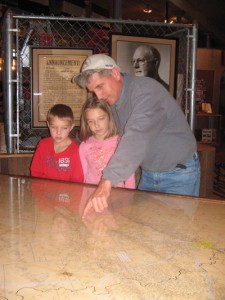
Museum Board Member Trey Bailey and his children examine an oilfield map almost a century after the 1920s Luling boom. Photo by Bruce Wells.
The Guinness Book of World Records has documented Luling’s watermelon seed-spitting with a distance of 68 feet, 9 and 1/8 inches, set in 1989. The distance reportedly is still unbeaten.
A Giant Oilfield
Although the Luling Oil Museum’s historic Walker Brothers building was a center for trading cotton, crude oil replaced cotton in Luling’s future thanks to Edgar B. Davis and his Rafael Rios No. 1 discovery well of August 9, 1922.

After drilling six consecutive dry holes near Luling, Davis’ heavily in debt United North & South Oil Company finally struck “black gold.” The wildcat well revealed an oilfield that proved to be 12 miles long and two miles wide.
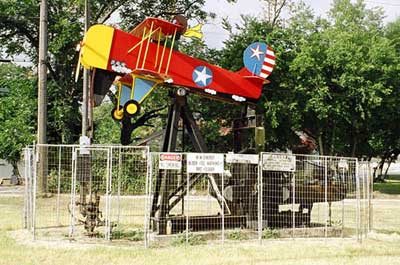
After sampling “the best ribs in the country,” visitors to Luling, Texas, marvel at the many decorated pump jacks seen in its historic downtown.
Some people proclaimed that Davis, president of the exploration company, found the town’s oil-rich geologic formation after getting a psychic reading from clairvoyant Edgar Cayce. A geologist working for Davis figured out the oilfield’s likely location.
“Many have called Edgar B. Davis eccentric, and perhaps it was his unconventional personality that led to several half-truths about a career that would be exceptional without embellishment,” noted Riley Froh in a 1979 article in the East Texas Historical Journal.
In the early summer of 1922, Davis was struggling financially when he located the oilfield’s discovery well five miles northwest of Luling. “Drilling on the recommendation of only one geologist and against the advice of several, Davis located his seventh well at random,” Froh reported.
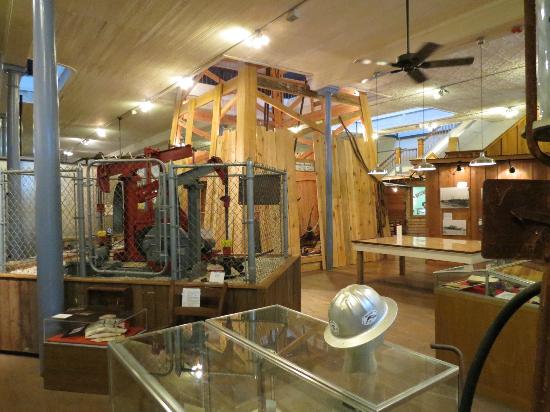
Luling’s downtown museum preserves “the vibrant life and times of ‘the toughest town in Texas’ and the oil boom in the Central Texas oil patch.” Photo courtesy Luling Oil Museum.
By 1924, Luling was a top-producing oilfield in the United States, exceeding the early 1900s fields of southeastern Texas, including Sour Lake and even the world-famous Spindletop Hill.
Exhibits at the Luling Oil Museum focus on the real science behind the discovery, which resulted in the town’s population skyrocketing from less than 500 people to 5,000 people within months after the Rafael Rios No. 1 well.
Psychic Dreams of Oil
Biographers of the once-famous American psychic Edgar Cayce have noted that he found his own mysterious path into exploring the oil patch at Luling. In 1904, Cayce was a 27-year-old photographer when a local newspaper described his “wonderful power that is greatly puzzling physicians and scientific men.”
The Hopkinsville Kentuckian reported that Cayce – from a hypnotic state – could seemingly determine causes of ailments in patients he never met. By 1910, the New York Times proclaimed that “the medical fraternity of the whole country is taking a lively interest in the strange power possessed by Edgar Cayce to diagnose difficult diseases while in a semi-conscious state.”

As his reputation grew, Cayce expanded his photography business with the addition of adjacent rooms and a specially made couch so he could recline to render readings. He became known as “The Sleeping Prophet” while his readings expanded beyond medical diagnoses into reincarnation, dream interpretation, psychic phenomenon…and advising oilmen.
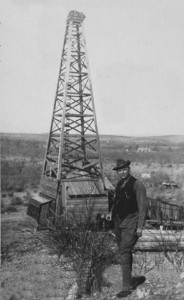
Edgar Cayce visited his drilling site in San Saba County, Texas, in 1921. The once-famous psychic’s abilities failed him searching for oil.
Sidney Kirkpatrick, author of Edgar Cayce: An American Prophet , explained that Cayce in 1919 provided detailed trance revelations to several oilmen probing the prolific Desdemona oilfield in Eastland County, Texas. The results reportedly inspired Cayce and several partners to form their own company.
, explained that Cayce in 1919 provided detailed trance revelations to several oilmen probing the prolific Desdemona oilfield in Eastland County, Texas. The results reportedly inspired Cayce and several partners to form their own company.
In September 1920, Cayce became the clairvoyant partner of Cayce Petroleum Company. Guided by his own psychic readings, Cayce Petroleum Company leased some acreage around Luling. Not far away, Edgar B. Davis had drilled eight dry holes and nearly gone broke before completing the discovery well for Luling’s oilfield.
But raising capital for Cayce Petroleum drilling proved difficult and eventually led to loss of the Luling leases. Cayce’s company tried again 150 miles north in San Saba County, Texas, and according to Kirkpatrick’s book, Cayce’s readings included “detailed descriptions given of the various rock geological formations that would be encountered as they drilled.”
Cayce Petroleum’s Rocky Pasture No. 1 well would drill beyond 1,650 feet in search of what Cayce described as a “Mother Pool,” capable of producing 40,000 barrels of oil a day. The psychic’s exploration company did not find any oil, ran out of money, and failed.
Salt Dome Faults
In a 2017 email to the American Oil & Gas Historical Society, long-time AOGHS member Dan Plazak noted Cayce spoke of finding oil at a salt dome at Luling. Petroleum and the geology of salt domes had been in the news since one had been revealed at Spindletop Hill in 1901, thanks to the persistence of Patillo Higgins, “Prophet of Spindletop.”

Plazak, a consulting geologist and engineer, reported that Cayce, “speaking in a trance, proclaimed that oil would be found at Luling associated with a salt dome. But there are no salt domes at Luling, and Cayce’s bad psychic advice could only have prevented Davis from finding oil.
“It was a geologist working for Davis who saw faulting in the outcrop and correctly predicted that the oil would be trapped behind the fault,” Plazak added.
An associate of Cayce, David Kahn, later wrote Davis asking the successful oilman to give some of the Luling profits to Cayce, but Davis declined. “Edgar Davis was famously generous, but his refusal to reward Cayce indicates that he didn’t consider Cayce to have been of much help,” explained Plazak in an email to AOGHS.
However, the geologist added, Davis continued to consult Cayce concerning possible presidential ambitions — Davis had convinced himself he was destined for the White House.
Plazak explained that it was a geologist working for Davis who saw faulting in the outcrop, and correctly predicted that the oil would be trapped behind the fault.
After a few early wells, “Cayce’s oil-exploration readings were a complete bust, both for his own oil company and later for many other oil drillers, in locations all over the country.”
In his email, Plazak — a “geologist and researcher of finding oil with doodlebugs, dreams, and crystal balls” from Colorado — added there are still those today who believe in psychic advice who no doubt are “raising money on the internet to drill yet another dry hole in San Saba County.”
Despite the psychic’s exploration readings not working, investors apparently can still be tempted with promotions of Cayce’s ability to find a “mother pool of oil.” More interesting research from oil patch detective Dan Plazak can be found at Mining Swindles.

A graduate of Michigan Tech and the Colorado School of Mining, Plazak in 2010 wrote “an entertaining and informative volume that delightfully investigates the history of mining frauds in the United States from the Civil War to World War I,” according to his publisher, the University of Utah Press.
“In his estimable work, A Hole in the Ground with a Liar at the Top, Dan Plazak strikes it rich with his examination of the old west’s most successful villains and their crimes.” — Utah Historical Quarterly
Modern “Crudoleum”
Today, the psychic legacy of failed oilman Edgar Cayce lives on at the Association for Research and Enlightenment in Virginia Beach, Virginia, founded in 1931, and “the official world headquarters of the works of Edgar Cayce, considered America’s most documented psychic.”
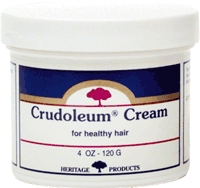
A psychic’s creamy petroleum product “for healthy hair” sold today.
An invention from Cayce’s venture into the oil business remains on the market — his “pure crude oil” product he recommended as a first step toward replenishing healthy hair. Cayce invented a “pure crude oil” product he called Crudoleum, which is sold today as a cream, shampoo and conditioner. Baar Products Inc. of Downingtown, Pennsylvania, offers Crudoleum Pennsylvania Crude Oil Scalp Treatment.
Learn more U.S. petroleum history by visiting the Luling Oil Museum in the historic Walker Brothers building in downtown Luling.
_______________________
Recommended Reading: Texas Art and a Wildcatter’s Dream: Edgar B. Davis and the San Antonio Art League (1998); Drilling Technology in Nontechnical Language
(1998); Drilling Technology in Nontechnical Language (2012); Edgar Cayce: An American Prophet
(2012); Edgar Cayce: An American Prophet (2001); A Hole in the Ground with a Liar at the Top: Fraud and Deceit in the Golden Age of American Mining (2010). Your Amazon purchase benefits the American Oil & Gas Historical Society. As an Amazon Associate, AOGHS earns a commission from qualifying purchases.
(2001); A Hole in the Ground with a Liar at the Top: Fraud and Deceit in the Golden Age of American Mining (2010). Your Amazon purchase benefits the American Oil & Gas Historical Society. As an Amazon Associate, AOGHS earns a commission from qualifying purchases.
_______________________
The American Oil & Gas Historical Society (AOGHS) preserves U.S. petroleum history. Please become an AOGHS annual supporter and help maintain this energy education website and expand historical research. For more information, contact bawells@aoghs.org. © 2025 Bruce A. Wells.
Citation Information – Article Title: “Central Texas Oil Patch Museum.” Authors: B.A. Wells and K.L. Wells. Website Name: American Oil & Gas Historical Society. URL: https://aoghs.org/energy-education-resources/luling-oil-field. Last Updated: July 31, 2025. Original Published Date: June 21, 2015.
by Bruce Wells | Jul 22, 2025 | Energy Education Resources
California oil seeps created asphalt pools — not tar — that trapped Ice Age animals.
The sticky black pools attracting tourists between Beverly Hills and downtown Los Angeles are natural asphalt, also known as bitumen. Although the repetitive tar pits’ name has stuck, the seeps are part of America’s oil history.
The La Brea site — discovered by a Spanish expedition on August 3, 1769 — originated from naturally produced California oil seeps found onshore and offshore. (more…)
by Bruce Wells | Jul 18, 2025 | Energy Education Resources
A geologist tracks down the first references to petroleum.
Petroleum geologist and historian Raymond P. Sorenson has spent much of his professional career writing about the oil and natural gas exploration and production industry.
Among Sorenson’s ongoing projects is documentation of the earliest signs of oil worldwide, including references to hydrocarbons long before the 1859 first U.S. oil well drilled 69.5 feet into the Venango sands of Pennsylvania.
About three centuries earlier, a Spanish expedition in the Gulf of Mexico led by Don Luis de Moscoso landed at the mouth of the Sabine River in the future state of Texas. The New World explorers in 1543 discovered Indians had for centuries utilized natural seeps to waterproof canoes, apply to abrasions, and more.

A Spanish expedition in 1543 used brigantines to explore the coast of the Gulf of Mexico.
Sorenson, retired and living in Tulsa, initially focused his research on geological surveys, reports from other exploring expeditions, and scientific journals. He then progressed to references cited by others, concentrated his efforts on North America and English language sources — the most readily available — but discovered rare sources as well.
Oil in Antiquity to Today
The petroleum geologist’s ongoing work has added more than 740 reference pages (with captured images) of his sources for the earliest signs of hydrocarbons in North America and other parts of the world.
In 2002, Sorenson shared with the American Oil & Gas Historical Society his 59-page bibliography of “Pre-Drake” publications. “For the past few years I have been engaged in a systematic study to document what was known about oil and natural gas prior to the Drake well,” he noted.

“I have an additional list of cited references that I have not yet examined of comparable size,” Sorenson added in a follow-up email to AOGHS. “The majority are in languages other than English, and I suspect that many of them will not be accessible through my library resources (or my linguistic skill set).”
A petroleum historian and consulting geologist based in Tulsa, Oklahoma, Sorenson explained in his email to AOGHS that to aid researchers, he has been using images of every page that contains relevant material, posting the full reference information at the top, and outlining the relevant portion of the text.
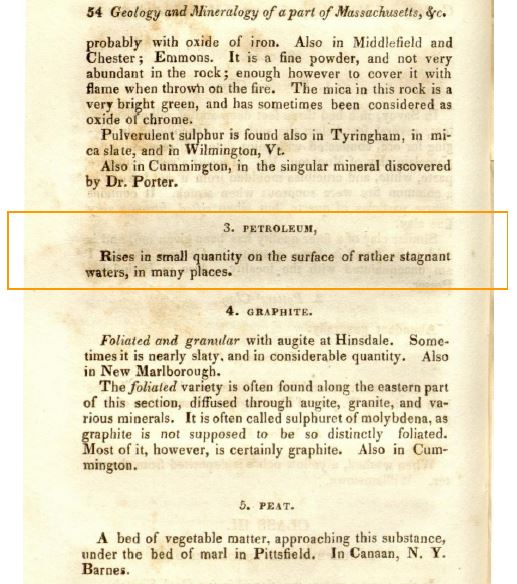
An 1835 reference to signs of oil and natural gas in Massachusetts prior to the first commercial U.S. oil well in Pennsylvania. Image courtesy Ray Sorenson.
“So far I have found relevant information in more than 550 publications with over 3,500 net pages, covering at last count 31 states, five Canadian provinces, and many foreign countries on other continents,” Sorenson noted in January. “For several topics, I have created subsets. I expect to continue to build the collection.”
In addition to antiquity references, Sorenson’s research for his “Pre-Drake Literature Collections by Subject” has thus far included:
California, Canada, Central & South America, Early Geologists, Europe, Fiction, Humboldt, Industrial & Laboratory, Initial Reactions, Kentucky, Maps & Figures, Medicinal , Middle East Asia Africa, Midwest, New England, New York, Oil & Gas Wells Pre-Drake, Ohio, West Virginia, Pennsylvania, Religious, Scientific American, Shales that Burn, Southern United States, Taylor R.C., Statistics of Coal, Textbooks, Volcanoes and Earthquakes, David Wells, Annual of Scientific Discovery, and Western United States.

Although many of his discoveries were found in obscure scholarly journals, Sorenson also found petroleum references in popular 19th-century publications. For example, the April 18, 1829, issue of “Niles’ Register” reported a Kentucky salt well driller finding oil.
“We have just conversed with a gentleman from Cumberland county, who informs us that in boring through rocks for salt water, a fountain of petroleum, or volatile oil, was struck, at the depth of 180 feet,” the Baltimore publication noted on page 117.
Sorenson’s Research Gigabytes
A long-time member of the American Association of Petroleum Geologists (AAPG) and the Petroleum History Institute (PHI), Sorenson has made many presentations and published academic papers with both. He submitted to PHI a paper on his history of oil and natural gas production from wells prior to 1859 for the journal Oil-Industry History.
The wells were drilled seeking water or brine, but Sorenson found one that flowed an estimated 2,500 barrels of oil per day in the 1820s.
In 2007, Sorenson adapted many of his contributions to AAPG for its extensive Discovery Series with “First Impressions: Petroleum Geology at the Dawn of the North American Oil Industry.” In January 2013, his “Historic New York Survey Set High Geologic Standards” was published in AAPG Explorer magazine, one of his many contributions to that publication.

Sorenson, who also has assisted with AOGHS articles (see Rocky Beginnings of Petroleum Geology), noted in his email that he has no plans to provide this collection in searchable form on a website, but will work with anyone who is conducting similar research.
Everything in the Sorenson collection is preserved in hard copy and digital (PDF) form, adding up to 11 feet of shelf space — about 27 gigabytes of computer memory.
Sorenson intends to give his full collection of research to the Drake Well Museum and Park in Titusville, at the site where Edwin L. Drake first found oil in the upper Venango sands.
Today, the Oil Region Alliance of Business, Industry and Tourism proclaims that historic part of northwestern Pennsylvania, “The Valley that Changed the World.”
For more information about Ray Sorenson’s on-going oil history projects and resources, post a comment below.
_______________________________
1859 Pennsylvania Well
The beginning of the science of petroleum geology might be traced to 1859 when a new industry began in western Pennsylvania. An oil well drilled in 1859 by former railroad conductor Edwin L. Drake along Oil Creek at Titusville sought oil for making kerosene, a new lamp fuel at the time made from coal.
Slowed by delays in receiving funds for what locals called “Drake’s Folly” and drilling with a steam-powered cable-tool rig, it took Drake more than a year to find oil at a depth of 69.5 feet. He also made his own innovations along the way, including adding a 10-foot cast iron pipe to the bore hole — a first.
To the relief of company founder George Bissell and investors in the Seneca Oil Company of New Haven, Connecticut, Drake completed the first U.S. oil well drilled specifically for oil. The August 27, 1859, discovery came in a geologic formation that would be called the Venango sands.
_______________________
Recommended Reading: Trek of the Oil Finders: A History of Exploration for Petroleum (1975); The Birth of the Oil Industry (1936); The Prize: The Epic Quest for Oil, Money & Power (2008); Myth, Legend, Reality: Edwin Laurentine Drake and the Early Oil Industry
(2008); Myth, Legend, Reality: Edwin Laurentine Drake and the Early Oil Industry (2009). Your Amazon purchase benefits the American Oil & Gas Historical Society. As an Amazon Associate, AOGHS earns a commission from qualifying purchases.
(2009). Your Amazon purchase benefits the American Oil & Gas Historical Society. As an Amazon Associate, AOGHS earns a commission from qualifying purchases.
_______________________
The American Oil & Gas Historical Society (AOGHS) preserves U.S. petroleum history. Please become an AOGHS annual supporter and help maintain this energy education website and expand historical research. For more information, contact bawells@aoghs.org. © 2025 Bruce A. Wells.
Citation Information – Article Title: “Sorenson Oil History Project.” Authors: B.A. Wells and K.L. Wells. Website Name: American Oil & Gas Historical Society. URL: https://aoghs.org/energy-education-resources/exploring-the-earliest-signs-of-oil. Last Updated: July 18, 2025. Original Published Date: August 5, 2020.
by Bruce Wells | Jul 15, 2025 | Energy Education Resources
Petroleum industry women convened in 1952 at the Shamrock Hotel in Houston.
Since its founding a few years after World War II, a national association of women in the petroleum business has “ebbed and flowed with the tides of the energy and allied industries.”
The organization began when a secretary at Humble Oil & Refining Company organized a 1949 meeting in New Orleans. Three years later, representatives from other cities gathered there to establish the Association of Desk and Derrick Clubs (ADDC) of North America.

After a 1949 meeting in New Orleans, petroleum industry secretaries organized chapters to establish the Desk and Derrick Club in 1952.
Articles of association were signed on July 23, 1951, by the president of the New Orleans club and the presidents of clubs founded in Jackson, Mississippi, Los Angeles, California, and Houston, Texas. The newly organized group of businesswomen began promoting energy education in the United States and Canada.
Greater Knowledge
“Greater Knowledge — Greater Service” became the ADDC motto of women working primarily as secretaries in the oil and natural gas industry. Many began organizing clubs in dozens of other oil-producing states.
ADDC got its start thanks to the Humble Oil secretary, who established the first club in New Orleans. A company secretary, Inez Awty (later Schaeffer), frustrated from writing reports about things she knew little about, “believed women working for oil companies wanted to see and know more about a derrick and other aspects of the industry,” noted a 2012 article in the Permian Basin Petroleum Association’s PB Oil & Gas.
Awty worked for Humble Oil & Refining Company, founded in 1911, thanks to a giant oilfield discovery at Humble, Texas, four years after the famous 1901 Spindletop gusher. Production from the Humble field exceeded the total for Spindletop by 1946.
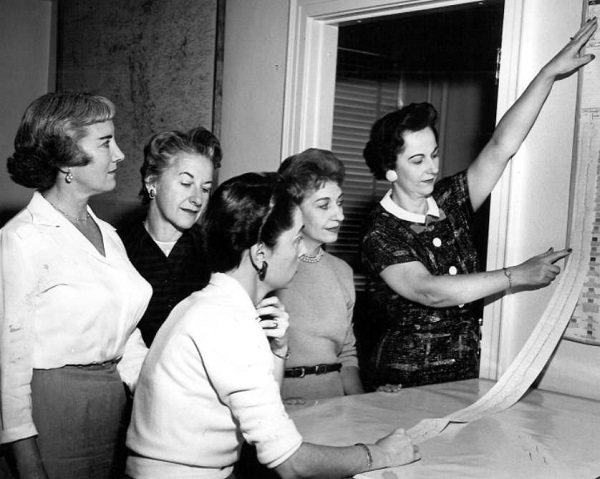
By 1951, there were 1,500 Desk and Derrick members in the United States and Canada. Photo courtesy Permian Basin Petroleum Association.
“Miss Awty thought if men in the oil industry could be organized and know other men outside their own company, then the women could do likewise,” the Midland Reporter-Telegram reported in 1951.
The charter clubs dedicated themselves to “the education and professional development of individuals employed in or affiliated with the petroleum, energy and allied industries and to educate the general public about these industries.”
The PB Oil & Gas article added that in April 1957, the club’s guest speakers included a young Midlander named George H.W. Bush, who reviewed offshore drilling operations in the Gulf of Mexico.
“Bit of Fun”
Educating youth about the earth sciences and how the modern petroleum industry works is part of the Desk and Derrick mission. In 1957, the organization’s members adopted a motto, “Greater Knowledge — Greater Service.”
Since 2004, the group has published (in English and Spanish) “Bit of Fun with PetroMolly and PetroMack,” an energy activity book designed for third and fourth graders.
In 1982, ADDC established The Desk and Derrick Educational Trust, “for the purpose of awarding scholarships to students pursuing a degree in a major field of study related to the petroleum, energy, or allied industries, with the objective of obtaining full-time employment in the industry.”
In addition, ADDC began to assist members in developing new educational projects and programs.
In 2018, about 1,200 women and men employed in or affiliated with the energy and allied industries comprised 48 clubs in seven regions. Membership numbers fluctuate in close relation to the state of the oil and gas industry — and oil prices.

ADDC has since continued to promote its energy education mission using a variety of programs, including seminars, field trips, and individual clubs hosting the annual national convention.
“Thousands of hours of education have been provided for members through monthly programs on the many facets of this industry and given by speakers ranging from company CEOs to oil-well-fire fighters.”
ADDC Milestones
1949 – The first club is founded in New Orleans by Inez Awty Schaeffer.
July 23, 1951 – Articles of association are signed by presidents of the clubs founded earlier in New Orleans, Los Angeles, Houston and Jackson, Mississippi.
December 1-2, 1951 – First Board of Directors meeting in New Orleans.

ADDC published its first “Bit of Fun” Energy Activity Book in 2004.
1952 – A newsletter is published (today’s The Desk and Derrick Journal) after Josephine Nolen of Odessa, Texas, wins a contest for its name: The Oil and Gal Journal.
1952 – The first convention is held at the Shamrock Hotel in Houston, led by the first association president, Lee Wilson Hoover. Forty member clubs are represented by almost 1,000 registrants. The Shamrock Hotel became the largest in the United States at the time. Independent producer Glenn H. “Diamond Glenn” McCarthy spent $21 million to build it.
1957 – “Greater Knowledge — Greater Service” is adopted as a motto.
1977 – “of North America” is deleted from the association’s name and the acronym ADDC becomes common usage.
1982 – ADDC established The Desk and Derrick Educational Trust for awarding scholarships to students pursuing a degree in a major field of study related to the petroleum, energy, or allied industries.
1987 – Foundation is established, and the first issue of The Desk and Derrick Journal published, replacing the Oil and Gal Journal.

1988 – Delegates at the annual convention approve equitable membership in the association, opening membership to men.
1996 – The first association website goes online in September.
2001 – Celebration of the association’s 50th anniversary year.
2004 – ADDC publishes its first “Bit of Fun” energy activity book.
2010 – Website is improved.
2025 Regions & Clubs
The 73rd annual ADDC Convention and Education Conference, is planned for September 16 – 21 at the Estancia del Norte in San Antonio, Texas. The 2024 gathering took place in Dallas.

Map of Association of Desk & Derrick Clubs courtesy ADDC.org.
Central Region Clubs: Graham, Great Bend, Liberal, Lone Star Club of Dallas, Oklahoma City, Tulsa, Wichita, and Wichita Falls.
Northeast Region Clubs: Three Rivers, Tri-State, and Tuscarawas Valley.
Southeast Region Clubs: Baton Rouge, Lafayette, New Orleans, Red River, San Antonio, Victoria, and Westbank.
West Region Clubs: Abilene, Amarillo, Artesia, Farmington, Grande Prairie, Midland, Pampa, and Roswell.
Oil Patch Field Trips
The association’s conventions often have included field trips to onshore and offshore drilling platforms, refineries, drill-bit manufacturing plants, pipeline facilities, and other petroleum industry locations.
During the 62nd convention in 2013 at Charleston, West Virginia, coordinator Melinda Johnson managed a theme of “Autumn in Appalachia.” The local club included 95 oil and natural gas companies. The convention program offered seminars — and the choice of five day-long field trips.
Among the 62nd convention seminars were Five Traits of Professionalism; Intro to Petroleum Engineering; Hot Oil and Gas Plays in the Appalachian Basin; Formulas and More — Excel Training; and Leadership and Effective Communication.

Further, on one of the field trips, service company representatives from Nabors Services provided a seminar and demonstration on fracturing treatments in the Marcellus Shale. Convention attendees learned the steps in performing a hydraulic fracturing treatment and the difference between how a conventional reservoir and an unconventional reservoir is fractured.
Another field trip visited a Halliburton oilfield service yard for education on coil tubing — with a “snubbing” unit demonstration. Still another trip toured a Baker Hughes center in Clarksburg, where visitors learned about directional drilling and viewed downhole motors, rotary steerable subs, and different kinds of drill bits.
_______________________________
The American Oil & Gas Historical Society (AOGHS) preserves U.S. petroleum history. Please become an AOGHS annual supporter and help maintain this energy education website and expand historical research. For more information, contact bawells@aoghs.org. © 2025 Bruce A. Wells.
Citation Information – Article Title: “Desk and Derrick Educators.” Author: AOGHS.ORG Editors. Website Name: American Oil & Gas Historical Society. URL: https://aoghs.org/energy-education-resources/desk-derrick-educators. Last Updated: July 20, 2025. Original Published Date: July 21, 2014.
by Bruce Wells | Jul 1, 2025 | Energy Education Resources
Visiting America’s many petroleum museums is easy.
Summertime brings new visitors to community oil and gas museums, including teachers and students anticipating the return of field trips and K-12 programs as the school year approaches. The American Oil & Gas Historical Society advocates visiting these frontline energy educators.
Whether visited on vacation or during the school year, petroleum museums in Texas , Oklahoma, California, and Pennsylvania offer earth science and other petroleum-related exhibits. Visitors to all of oil and gas museums often are met by volunteer docents — retired petroleum geologists, engineers, or other oilfield professionals.
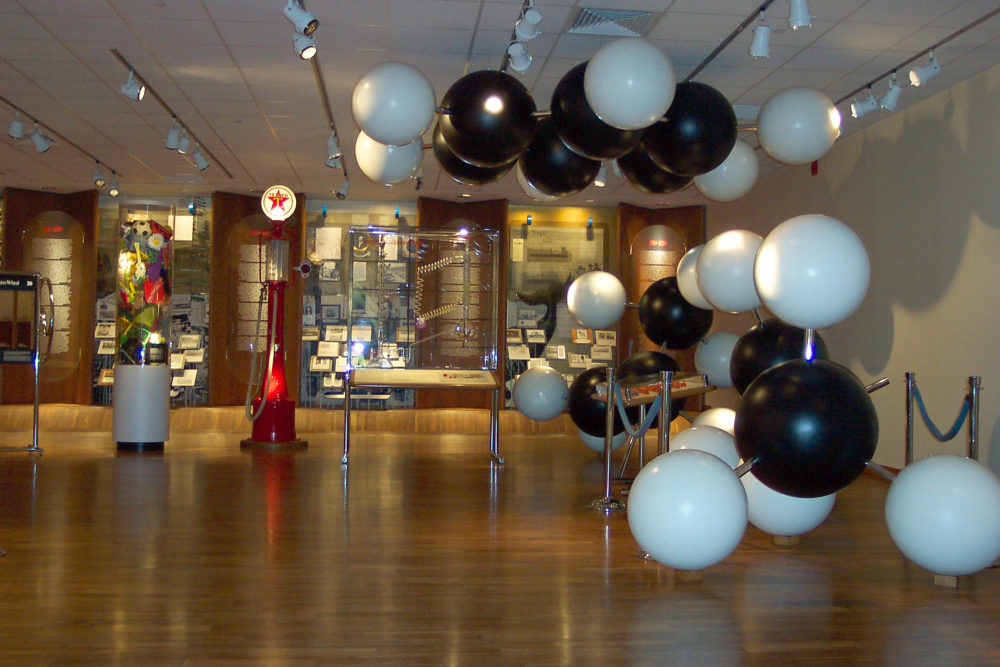
Petroleum exhibits educate visitors to the Texas Energy Museum in Beaumont, where a 1901 oil discovery at Spindletop Hill launched the modern petroleum industry. Photo by Bruce Wells.
In Texas, the Petroleum Museum in Midland includes many summer energy education programs for kids, as does the Ocean Star, an offshore rig museum in Galveston. Many community museums also are part of annual “derrick festivals,” which take place in Taft, California (West Kern Oil Museum), and other states with oil and gas production.
Alabama has a small county museum in Gilbertown with an “old Hunt oil rig” similar to the one that discovered the first oilfield in Alabama in 1944.
Further, many oil patch communities celebrate their petroleum heritage every summer with parades, special events, and museum tours.

Visitors to the Drake Well Museum at Oil Creek in Titusville, Pennsylvania, can tour a replica of Edwin L. Drake’s cable-tool derrick and steam engine house among other outdoor exhibits. Photo by Bruce Wells.
For those interested in the industry’s exploration and production history and traveling this summer, check out these exhibits chronicling the nation’s discoveries.
Western New York boasts a museum in Bolivar with some of the nation’s earliest petroleum artifacts. While dairying and livestock have become the cash crops, the region still produces a small amount of very high-quality oil and natural gas, says Director Kelly Lounsberry. This museum tells the story of oil and natural gas production in the region.

Exhibits at a museum in Bolivar, N.Y., include oilfield engines, maps, documents, pictures, models and tools. Wonderful Wizard of Oz author L. Frank Baum once owned a petroleum products company there – and sold oil cans. Photo by Bruce Wells.
The first U.S. well specifically intended to obtain natural gas was dug near Fredonia by William Hart, who had noticed gas bubbles on the surface of a creek. In 1821, he dug a 27-foot well and built a “log pipe” to bring gas to nearby houses for lighting.
Hart’s work led to the formation of the Fredonia Gas Light and Water Works Company – the first U.S. natural gas company, according to the American Gas Association, Washington, D.C., which was founded in 1918.
Further, thanks to the region’s oilfield production, L. Frank Baum opened a petroleum products business in Syracuse, N.Y., in 1883. The future author of The Wonderful Wizard of Oz once sold buggy wheel axle grease — and oil cans (learn more in Oil in the Land of Oz).

Just to the south of Bolivar, there are many museums and historic attractions in the state where the modern industry began: Pennsylvania.
East of I-79 in northwestern Pennsylvania, the Drake Well Museum in Titusville exhibits “Colonel” Edwin Drake’s famous August 27, 1859, discovery well – today recognized as the first U.S. oil producer.
The Drake Well Museum’s outdoor exhibits include a recreation of the original cable-tool derrick Drake used. Among the most popular summer attractions for young students is the “Nitro” well-fracturing reenactment demonstrating the use of “go-devils” for fracturing a well.
Visitors also can stop by the museum gift shop to find a reprint of The Early Days of Oil, by Dr. Paul Giddens, considered to be the “Bible” of information about the birth of the U.S. petroleum industry. Many images in the book are from originals made by photographer John A. Mather and preserved at the museum.
Located on 270 Seneca Street in Oil City – in a Beaux Arts building listed in the National Register of Historic Places – the Venango Museum of Art, Science & Industry preserves the oil region’s industrial heritage. Its exhibits include a 1928 Wurlitzer Theater Organ.

Once a world-famous Pennsylvania boom town, visitors today can walk the grassy paths of Pithole’s former streets. Photo by Bruce Wells.
Another must-see oil history spot is the Pennsylvania Historical and Museum Commission’s Pithole Visitors Center — the site of a vanished 1865 oil boom town now managed by Drake Well Museum. The once infamous boom town is in Oil Creek State Park.
A dedicated group of railroad enthusiasts maintains the Oil Creek & Titusville Railroad, a nonprofit group that offers trips through the historic oil region. Near the railroad is the refurbished home of “Coal Oil” Johnny. Read his fascinating tale in the Legend of “Coal Oil Johnny.”

The Penn-Brad Oil Museum — and Historical Oil Well Park — is located three miles south of Bradford, Pennsylvania, on Route 219, near Custer City. Photo by Bruce Wells.
At nearby Oil City is a center dedicated to the study of the oil heritage region at Clarion University, Venango Campus. The Barbara Morgan Harvey Center for the Study of Oil Heritage contains hundreds of rare books of the region, newspaper clippings from the early 1900s, and even minutes from the meetings of early companies, maps, and photographs.
First Billion Dollar Oilfield
About 70 miles to the east of Titusville, the Penn-Brad Oil Museum (and historical oil well park) at Bradford takes visitors back to the early boom times of “The First Billion Dollar Oil Field.” Guided tours are conducted by retired geologists or petroleum engineers who volunteer their time to relate exciting first-hand experiences.
The museum in Custer City is three miles south of Bradford, along Rt. 219. Nearby is a refinery built in 1881 and still operated by the American Refining Group. The facility is considered the oldest continuously operating refinery in America.
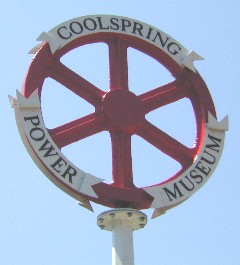
The museum maintains stationary internal combustion engines for education and enjoyment. Photo by Bruce Wells.
Before leaving Pennsylvania, visit one of the world’s largest collections of oilfield engines. Century old “hit and miss” gas engines, vintage oilfield equipment, and early electric generators are among the permanent exhibits at a unique “power museum” in Coolspring.
With perhaps the largest 19th-century engine collection in the world, the museum is housed in 13 buildings with about 250 engines – many of them operational.
The Coolspring Power Museum is located east of Pittsburgh just off Route 36 midway between Punxsutawney to the south and Brookville to the north. According to longtime Director Paul E. Harvey, the collection presents an illuminating history of the evolution of internal combustion technology that put an end to the steam-powered era.
Twice a year engine collectors from around the country gather on the extensive grounds – and the “barking” of hundreds of antique engines lasts several days.
Community oil and gas museums are linked to the AOGHS website. Museum events and K-12 education efforts are featured alongside stories of America’s petroleum heritage.
_______________________________
The American Oil & Gas Historical Society preserves U.S. petroleum history. Please become an AOGHS annual supporter and help maintain this energy education website and expand historical research. For more information, contact bawells@aoghs.org. © 2025 Bruce A. Wells.
Citation Information – Article Title: “Summer Travels to Oil Museums” Authors: B.A. Wells and K.L Wells. Website Name: American Oil & Gas Historical Society. URL: https://aoghs.org/energy-education-resources/pennsylvania-petroleum-vacation. Last Updated: July 6, 2025. Original Published Date: May 7, 2013.
























